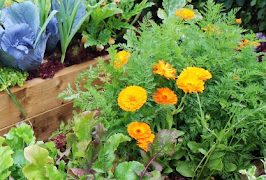Companion planting goes in and out of favor with gardeners. Some say "But it's not research based." Somewhere along the line, we became enamored with instant gardening results without physical or mental problem solving. Spray for this, spray for that, add some fast acting fertilizer if the plants look a little off. Sometimes we don't take the time to figure out the problem, we just pull it out.
One study reported that garden beans, green or yellow, planted with seed potatoes increased the size of the potato tuber. Other reports have shown that beans and potatoes planted in alternating rows reduces the numbers of Colorado potato beetles compared to single-crop plots.
Studying the vegetable that are considered a 'trap crop' is valuable if you want to eliminate pesticides. Radishes planted around a young tomato plant will draw in flea beetles minimizing damage to tomato transplants.
Radishes planted in a circle around cucumbers may act as a shield against cucumber beetles. Planting basil with tomatoes has been shown to limit egg-laying behaviors by the adult months whose leaf-eating larvae are known as tomato hornworms. Plant the basil close to the tomato plant but not so close as to restrict air movement and cause fungal diseases or alternate rows of basil and tomatoes.
A study on an Iowa State research farm found that partnering broccoli and cabbage plants with thyme resulted in significantly reduced egg-laying behaviors by the cabbage looper moths. Cabbage loopers are common pests of cole crops.Chapters include information on pest management, disease management, biological control and pollination.
As much as we grumble about our climate we should be grateful our climate isn't conducive to the insects in the south or the mid-west.




No comments:
Post a Comment
Let us know what you think of Gardening in Central Oregon.